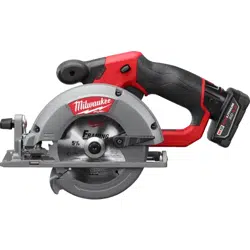Loading ...
Loading ...
Loading ...

7
Cross-Cutting Wood
Cross-cutting is cutting across the grain. Select the
proper blade for your job. Advance the saw slowly to
avoid splintering the wood.
Ripping Wood
Ripping is cutting lengthwise with the grain. Select the
proper blade for your job. Use a rip fence for rips 4" wide
or less. To install the rip fence, slide the bar through
the rip fence slot in either side of the shoe. The width
of the cut is the distance from the inside of the blade
to the inside edge of the rip fence. Adjust the rip fence
for the desired width, and lock the setting by tightening
the rip fence adjusting knob.
When ripping widths greater than 4", clamp or tack 1"
lumber to workpiece and use the inside edge of the
shoe as a guide.
WARNING
To reduce the risk of electric shock,
check work area for hidden pipes
and wires before making plunge cuts.
Plunge Cutting
Plunge cuts are made in the middle of the workpiece
when it can not be cut from an edge. We recommend
using a Sawzall
®
reciprocating saw or jig saw for this
type of cut. However, if you must use a circular saw
to make a plunge cut, USE EXTREME CAUTION. To
maintain control of the saw during plunge cutting, keep
both hands on the saw.
1. Beginning at a corner, line up the sight line with your
cutting line. Tilt the saw forward, rmly xing the front
of the shoe on the workpiece. The blade should be
just above cutting line, but not touching it. Raise the
lower guard using the lower guard lever.
2. To start the saw, push the lock-o button down while
pulling the trigger. Allow the motor to reach full speed
before beginning cut. Using the front of the shoe as
a hinge point, gradually lower the back end of the
saw into the workpiece. Release the lower guard
lever and grasp the front handle.
3. When the shoe rests at against workpiece, advance
the saw to the far corner. Release the trigger and
allow the blade to come to a complete stop before
removing it from workpiece. Repeat the above steps
for each side of the opening. Use a Sawzall
®
recip-
rocating saw, jig saw or small hand saw to nish the
corners if they are not completely cut through.
Overloading
Continuous overloading may cause permanent dam-
age to tool or battery pack.
Cutting Masonry and Metal
MILWAUKEE circular saws are not intended for con-
tinuous use in cutting metal or masonry. When cutting
these materials, use the correct blade. MILWAUKEE
does not recommend using bonded abrasive wheels
on circular saws for any application.
WARNING
Dust, chips, and grit can cause
guard to hang up at any time. If saw
is used to cut masonry or metal, reserve and mark
it for that purpose only and return it to a
MILWAUKEE service facility for cleaning and
testing before using it for wood cutting.
Only use accessories with maximum speed rating
at least as high as nameplate RPM of tool.
When cutting masonry, use a diamond blade. Make
successive passes at depths of less than 1/4" to
achieve the desired depth. Cutting at a depth of more
than 1/4" will damage wheel. Remove battery pack
and frequently clean dust from air vents and guards.
WARNING
Do not use tool for cutting metal
near ammable material. Sparks
may cause re.
When cutting metal, use a metal cutting blade. Set depth of
cut to full depth. Protect everyone in the area from sparks.
MAINTENANCE
WARNING
To reduce the risk of injury, always
unplug the charger and remove the
battery pack from the charger or tool before
performing any maintenance. Never disassemble
the tool, battery pack or charger. Contact a
MILWAUKEE service facility for ALL repairs.
Maintaining Tool
Keep your tool, battery pack and charger in good
repair by adopting a regular maintenance program.
Inspect your tool for issues such as undue noise,
misalignment or binding of moving parts, breakage of
parts, or any other condition that may aect the tool
operation. Return the tool, battery pack, and charger
to a MILWAUKEE service facility for repair. After six
months to one year, depending on use, return the
tool, battery pack and charger to a MILWAUKEE
service facility for inspection.
If the tool does not start or operate at full power with
a fully charged battery pack, clean the contacts on
the battery pack. If the tool still does not work prop-
erly, return the tool, charger and battery pack, to a
MILWAUKEE service facility for repairs.
WARNING
To reduce the risk of personal in-
jury and damage, never immerse
your tool, battery pack or charger in liquid or
allow a liquid to ow inside them.
Cleaning
Clean dust and debris from vents. Keep handles
clean, dry and free of oil or grease. Use only mild
soap and a damp cloth to clean, since certain clean-
ing agents and solvents are harmful to plastics and
other insulated parts. Some of these include gasoline,
turpentine, lacquer thinner, paint thinner, chlorinated
cleaning solvents, ammonia and household deter-
gents containing ammonia. Never use ammable or
combustible solvents around tools.
Repairs
For repairs, return the tool, battery pack and charger
to the nearest service center.
Loading ...
Loading ...
Loading ...
